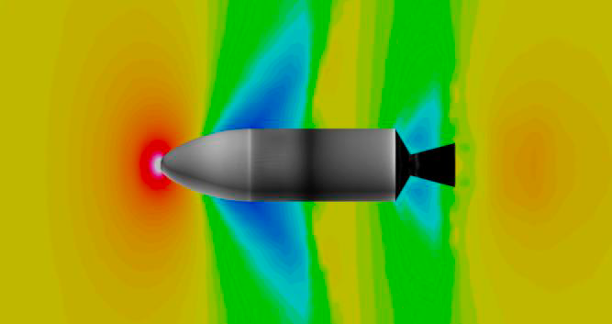Numerical Study on Aerodynamic Characteristics of Mars Helicopter and Mars Rocket
JAXA Supercomputer System Annual Report February 2023-January 2024
Report Number: R23EACA41
Subject Category: JSS Inter-University Research
- Responsible Representative: Makoto Sato, Associate Professor, Kogakuin University
- Contact Information: Makoto Sato, Kogakuin University(msato@cc.kogakuin.ac.jp)
- Members: Makoto Sato, Yuriko Shiratsuchi, Kota Yoshikawa
Abstract
The ISAS/JAXA is leading a research and development project for a Mars helicopter aimed at exploring Martian caves. In the Oyama Laboratory at the ISAS, experimental studies has been conducted to measure the aerodynamic characteristics of a Mars helicopter under low-pressure conditions simulating the Martian atmosphere. In the present research, numerical simulations of the flow around various Mars helicopter rotors are coducted under the same conditions as the experiments, to elucidate the rotor’s aerodynamic characteristics and flow physics.
Furthermore, research on a Mars sample return rocket has been conducted at the Oyama Laboratory of ISAS. Since it becomes the lower Reynolds numbers and higher Mach numbers on Mars compared to Earth, the knowledge about the optimal rocket shape suitable for Martian conditions is important. In the present study, numerical simulations of the flow around rockets in Martian conditions are conducted to determine the optimal Mars rocket shape based on its aerodynamic characteristics and flow physics.
Reference URL
N/A
Reasons and benefits of using JAXA Supercomputer System
We need to conduct the large-scale simulations on the rotational blade and the Mars rocket flows using “rFlow3D” and “FaSTAR”, which have been developed in JAXA.
Achievements of the Year
To investigate the compressibility effects on the flow around rotors for the Mars helicopter, numerical simulations were conducted on the single rotor of the Mars helicopter “HAMILTON” [1]. As a parameter, the tip Mach number of the rotor blades was varied from approximately 0.2 to 0.8. The Reynolds number was kept constant for each case. The simulation solver was rFlow3D, developed by JAXA.
Figure 1 represents the results for CT-CQ and CT-FoM for each case. From the results, while the effect of the tip Mach number is relatively low at the low CT region, it becomes significant at the high CT region. The rotor performance decreases as the tip Mach number increases and the effects of compressibility become stronger. Figure 2 shows the Cp distribution on the blade surface at pitch angles of 10 degrees and 20 degrees. The Cp at the 90% spanwise section of the blade is presented here. At the relatively low CT region with a pitch angle of 10 degrees, the effect of the tip Mach number is small. However, at the high CT region at a pitch angle of 20 degrees, clear differences in the Cp distribution appear, and for tip Mach numbers of 0.21 and 0.42, the Cp distribution similar to that of a laminar separation bubble due to flow reattachment is observed. Figure 3 shows the distribution of turbulent kinetic energy at the same section as Fig, 2. At a pitch angle of 10 degrees, the differences due to the tip Mach number are not clear. On the other hand, at a pitch angle of 20 degrees, for tip Mach numbers of 0.21 and 0.42, the regions of high turbulent kinetic energy form near the blade surface. This indicates that the turbulent transition and turbulent reattachment occur in the reigion.
Furthermore, to examine the effects of Reynolds number and Mach number on the flow around Mars rockets, numerical simulations were conducted on a shape previously proposed in the past literature [2]. Here, the Reynolds number and the Mach number were varied as a parameter. The numerical analysis solver was FaSTAR, developed by JAXA.
Figure 4 shows the flow around the rocket at a Reynolds number of 3.0*10^5 and a Mach number of 0.95. The background represents the pressure distribution, while the rocket surface shows the friction stress distribution. The simulation results reveal that aerodynamic characteristics differ, especially in the transonic region, between Earth and Martian environments.
[1] Sugiura, M., Tanabe, Y., Sugawara, H., Kimura, K., Oyama, A., Sato, M., Yoshikawa, K., Buto, Y., Kanazaki, M., Kishi, Y., Kikuchi, D., and Minajima, T., “Blade Shape Optimization of Mars Helicopter Exploring Pit Craters”, VFS Forum 78-paper93, 2022.
[2] Jeffrey V. Bowles, Loc C. Huynh, and Veronica M. Hawke:Mars Sample Return: Mars Ascent Vehicle Mission & Technology Requirements, NASA/TM-2013-216511, 2013.

Fig.3: Mtip effect on turbulent kinetic energy (upper: pitch angle of 10deg., lower: pitch angel of 20 deg.)
Publications
N/A
Usage of JSS
Computational Information
- Process Parallelization Methods: N/A
- Thread Parallelization Methods: OpenMP
- Number of Processes: 1
- Elapsed Time per Case: 1920 Hour(s)
JSS3 Resources Used
Fraction of Usage in Total Resources*1(%): 0.11
Details
Please refer to System Configuration of JSS3 for the system configuration and major specifications of JSS3.
| System Name | CPU Resources Used(Core x Hours) | Fraction of Usage*2(%) |
|---|---|---|
| TOKI-SORA | 2848767.77 | 0.13 |
| TOKI-ST | 4907.05 | 0.01 |
| TOKI-GP | 0.00 | 0.00 |
| TOKI-XM | 0.00 | 0.00 |
| TOKI-LM | 0.10 | 0.00 |
| TOKI-TST | 0.00 | 0.00 |
| TOKI-TGP | 0.00 | 0.00 |
| TOKI-TLM | 0.00 | 0.00 |
| File System Name | Storage Assigned(GiB) | Fraction of Usage*2(%) |
|---|---|---|
| /home | 1024.00 | 0.85 |
| /data and /data2 | 168710.00 | 1.04 |
| /ssd | 2510.00 | 0.24 |
| Archiver Name | Storage Used(TiB) | Fraction of Usage*2(%) |
|---|---|---|
| J-SPACE | 0.00 | 0.00 |
*1: Fraction of Usage in Total Resources: Weighted average of three resource types (Computing, File System, and Archiver).
*2: Fraction of Usage:Percentage of usage relative to each resource used in one year.
ISV Software Licenses Used
| ISV Software Licenses Used(Hours) | Fraction of Usage*2(%) | |
|---|---|---|
| ISV Software Licenses(Total) | 160.20 | 0.07 |
*2: Fraction of Usage:Percentage of usage relative to each resource used in one year.
JAXA Supercomputer System Annual Report February 2023-January 2024





